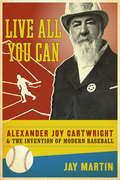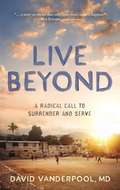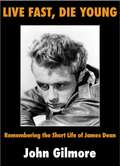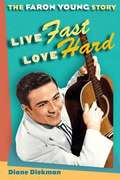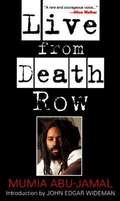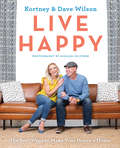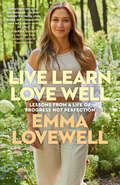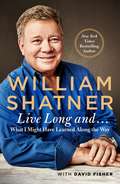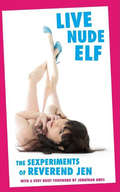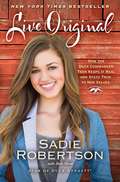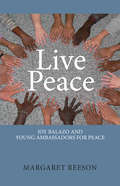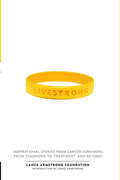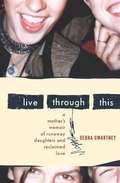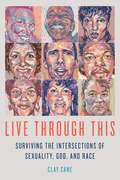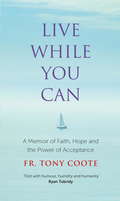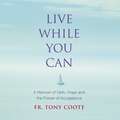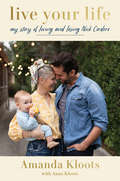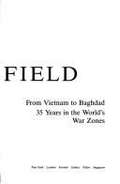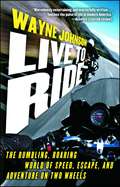- Table View
- List View
Live All You Can: Alexander Joy Cartwright and the Invention of Modern Baseball
by Jay MartinLaying waste to the notion that Abner Doubleday established the modern game of baseball, acclaimed biographer Jay Martin makes a bold case for A. J. Cartwright (1820-1892), an entrepreneur, philanthropist, and avid ballplayer whose keen perception and restless spirit codified the rules of the sport and engineered its rapid spread throughout the country.Consulting Cartwright's personal correspondence and papers, Martin shows how this American archetype synthesized a number of elements from popular ballgames into the program, bylaws, and positions we find on the field today. After formalizing his blueprint, Cartwright worked tirelessly to promote baseball nationwide, appealing to both upper- and lower-class spectators and ballplayers and weaving a trail of influence across nineteenth-century America. Addressing the controversy that has roiled for years around the claims for Doubleday and Cartwright, Martin revisits the original arguments behind each camp and throws into sharp relief the competing ambitions of these figures during a time of aggressive westward expansion and unparalleled opportunities for individual reinvention. Martin's story of modern baseball not only offers a fascinating window into a thoroughly American phenomenon but also accesses a rare history of American ideals.
Live Beyond: A Radical Call to Surrender and Serve
by David VanderpoolWhat would compel a successful surgeon to give up his practice in affluent Brentwood, Tennessee, to move to Haiti and serve the poorest of the poor?The catastrophic earthquake that devasted Haiti in 2010 was the motivation that Dr. David Vanderpool needed to completely change his life to follow the call of Jesus. For several years, he and his wife, Laurie, had been asking each other a daily question: What did you do yesterday that required faith? God&’s call to Dr. David Vanderpool&’s was so powerful that he organized medical and logistical relief to help the hundreds of thousands of desperate Haitians?suffering people with no water, food, or shelter, much less medical care. But it didn&’t stop there. The Vanderpools sold everything—surgical practice, home, belongings—to bring much-needed medical care to the people of Haiti. They established a nonprofit, LiveBeyond, to empower the impoverished. Today, its work continues with basic needs such as nutrition and water, in addition to health care, education, and agricultural assistance. The goal: achieve sustainable communities, beginning with the home base of Thomazeau, Haiti. The inspirational true stories of LiveBeyond&’s work in Haiti will lead you to ask yourself, What did I do yesterday that required faith? And maybe do something about it.
Live Fast, Die Young: Remembering the Short Life of James Dean
by John GilmoreLive Fast, Die Young: Rembering the Short Life of James Dean is a first -- revealing James Dean from the inside out by someone who knew him intimately, in more ways than one. John Gilmore hung out with Dean during the early days in New York, and again in Hollywood when Dean starred in his first movie, East of Eden. They pounded the pavements of Broadway together, raced motorcycles, had sex with the same women (and compared notes), experimented with gay sex, and tried to make love to another. "We were bad boys playing bad boys while opening up the bisexual sides of our separate personalities . . ." One sex scene between the two is played out in black leather to the music of Edith Piaf. "The sex was a game," Gilmore writes. "Jimmy was obsessed with riding the black ship to hell, and for that quick time I was on board with him." Dean found in the young Gilmore a "kind of unthreatening waste basket" into which he confided, dumping his chaotic, erotic and crazy ideas. "We enjoyed poetry and bullfighting, bongo drums, booze, and girls; knew the same crummy friends and sleepless, searching nights." Dean's insights into his brilliant Broadway success and the films that followed are revealed through Gilmore's story as are Dean's hatred of his disapproving father; his intimacy with his mother and their secret games that engendered Dean's sexual confusion in Hollywood; Dean's obsession with death; and the posthumous explosion of the legend. Through letters, diaries, tape-recorded conversations with the actor, and private remembrances by those closest to him, Gilmore constructs a never-before-seen portrait of the star.
Live Fast, Love Hard: The Faron Young Story
by Diane DiekmanAs one of the best-known honky tonkers to appear in the wake of Hank Williams's death, Faron Young was a popular presence on Nashville's music scene for more than four decades. The Singing Sheriff produced a string of Top Ten hits, placed over eighty songs on the country music charts, and founded the long-running country music periodical Music City News in 1963. Flamboyant, impulsive, and generous, he helped and encouraged a new generation of talented songwriter-performers that included Willie Nelson and Bill Anderson. In 2000, four years after his untimely death, Faron was inducted into the Country Music Hall of Fame. Presenting the first detailed portrayal of this lively and unpredictable country music star, Diane Diekman masterfully draws on extensive interviews with Young's family, band members, and colleagues. Impeccably researched, Diekman's narrative also weaves anecdotes from Louisiana Hayride and other old radio shows with ones from Young's business associates, including Ralph Emery. Her unique insider's look into Young's career adds to an understanding of the burgeoning country music entertainment industry during the key years from 1950 to 1980, when the music expanded beyond its original rural roots and blossomed into a national (ultimately, international) enterprise. Echoing Young's characteristic ability to entertain and surprise fans, Diekman combines an account of his public career with a revealing, intimate portrait of his personal life.
Live From Death Row
by Mumia Abu-JamalAwaiting execution for the murder of a Philadelphia policeman, the author describes the brutality and humiliation of prison life and argues that the justice system is racist and ruled by political expediency.
Live Happy: The Best Ways to Make Your House a Home
by Dave Wilson Kortney WilsonFrom the beloved couple behind Masters of Flip, a warm and inviting guide to making wherever you are feel like homeHome isn’t just a place to sleep and eat. It’s a haven—a place of refuge from the world, of connection with the people (and pets) you hold most dear, of celebration of life’s biggest moments and of recuperation from the exhaustion of the day. Kortney and Dave Wilson have built their careers and a beloved HGTV show, Masters of Flip, around creating houses that people instantly recognize as home. They build colour, joy and family into the design of every house they flip in Nashville, Tennessee, because those priorities are what shape their lives. Live Happy offers hundreds of fresh, fun ideas for how readers and fans of Masters of Flip can inexpensively and creatively build joy into their lives and their homes. From the reason you should always live close to the ice cream shop to the definitive philosophy for dealing with your junk drawer, it will help you make a new house into a home or inject new life into your forever home. It will go beyond design to personal connections, with stories of how Kortney and Dave found each other, built new dreams together and manage to have a happy marriage (and business!) while raising three amazing children. Full-colour and heavily illustrated, Live Happy will feature over 200 photos drawn from Kortney and Dave’s family and design projects. Think of it as The Wisdom of Sundays meets Domino with a shot of The Magnolia Story. Through it all, Kortney and Dave’s voices will be in hilarious and heartfelt conversation in the way fans have come to know and love on Masters of Flip.
Live Learn Love Well: Lessons from a Life of Progress Not Perfection
by Emma LovewellA memoir chronicling Emma Lovewell&’s incredible path to physical―and mental―fitness that traces her journey to becoming a beloved Peloton instructor and inspires readers to live, learn, and love well&“Emma&’s spirit and spark are contagious . . . a great reminder that feeling whole, healthy, and balanced takes work but is always worth the effort.&”—Joanna Gaines, #1 New York Times bestselling author of Magnolia TableEmma Lovewell is a star instructor at Peloton, a global fitness brand and media content company, but her journey to success began with a simple realization: Change is inevitable, but growth is optional. She chose to grow. In Live Learn Love Well, she shares the moments in her life that shaped her into the woman she is today―from growing up in a modest home amidst the affluence of Martha&’s Vineyard, to struggling with her biracial identity and fitting in, both in the white community and the Asian American community, to health setbacks and relationship challenges, to moving to New York and striving for a career in dance and fitness.Just as Lovewell is more than a fitness instructor, she&’s learned that wellness is more than merely a physical condition. She shares the moments where mental fortitude shaped her outlook on the world and how the idea of &“progress, not perfection&” became a guiding principle.Filled with surprising insights, charming anecdotes, and never-before-shared moments, Live Learn Love Well is for anyone who feels stuck or overwhelmed, who worries there&’s too much to change to even get started, or who simply needs a little inspiration to make tomorrow better than today. Lovewell&’s stories, along with her easy-to-initiate tips, will give readers the confidence to know that even the smallest modifications can have truly outsized impacts on their lives and wellness.
Live Long And . . .: What I Learned Along the Way
by William Shatner David FisherStar Trek legend and veteran author William Shatner discusses the meaning of life, finding value in work, and living well whatever your age."I have always felt," William Shatner says early in his newest memoir, that "like the great comedian George Burns, who lived to 100, I couldn’t die as long as I was booked." And Shatner is always booked. Still, a brief health scare in 2016 forced him to take stock. After mulling over the lessons he's learned, the places he's been, and all the miracles and strange occurrences he's witnessed over the course of an enduring career in Hollywood and on the stage, he arrived at one simple rule for living a long and good life: don't die.It's the only one-size-fits-all advice, Shatner argues in Live Long and..:What I Learned Along the Way, because everyone has a unique life—but, to help us all out, he's more than willing to share stories from his unique life. With a combination of pithy humor and thoughtful vulnerability, Shatner lays out his journey from childhood to peak stardom and all the bumps in the road. (Sometimes the literal road, as in the case of his 2,400-mile motorcycle trip across the country with a bike that didn't function.)William Shatner is one of our most beloved entertainers, and he intends never to stop entertaining. His funny, provocative, and poignant reflections offer an unforgettable read about a remarkable man.
Live Nude Elf: The Sexperiments of Reverend Jen
by Reverend JenLive Nude Elf: The Sexperiments of Reverend Jen chronicles Reverend Jen Miller's two-year series of adventures in love and sex in New York City The Reverend is a sort of elvish-speaking, Lower East Side version of Sex and the City's Carrie Bradshaw. The "sexperiments" range from harrowing (working as a live nude girl at Wiggles) to embarrassing (attending fellatio school) to transcendent (reaching a mystical state through tantric sex). Along the way there is transvestitism, female ejaculation, opium smoking, and heartbreak.In the Rev's "art star" world, where a twenty-one-year-old bisexual boy named Orion has sex with a jar of Mayonnaise, the more "mundane" acts of courtship, romance, and sex-kissing only, buying dinner for a lover, or just making eye contact in the sack-become themselves rare and subversive.After a year, Jen confesses to having "grown a little tired of having sex." The experimentation, the many "lab partners," the late nights and cans of Budweiser, "meant romance was hard to come by." After a decade of New York City flings, affairs, and a few failed relationships, Jen unexpectedly falls in love, and finally must decide between him and her art: can she continue a sex column and have a functional monogamous relationship? Or does the life implicit of a sex columnist preclude her from monogamous romantic love?
Live Original: How the Duck Commander Teen Keeps It Real and Stays True to Her Values (Live Original Ser.)
by Beth Clark Sadie RobertsonSeventeen-year-old Sadie Robertson--star of A&E's Duck Dynasty and daughter of Willie and Korie Robertson--shares her outlook on life as she opens up about herself and the values that make her family what it is.Sadie Robertson represents everything that a well-adjusted teenager should be, even while growing up in the spotlight on Duck Dynasty. She exhibits poise, respect for her family and friends, and a faith that influences her choices. Everyone wants to know how a family as eclectic as the Robertsons are raising such confident, fun, family-loving kids. With this book, Sadie sheds light on the values instilled by her family that make her the person she is. Sadie lives by a simple list of principles that lead her to personal and spiritual growth and allow the relationships she has with her friends and family to flourish. These values include think happy, be happy; dream big; shake the hate; do something; and many more. Living as a culturally relevant teen who loves God and her family, Sadie has become a role model for other teens and for parents who are eager to instill the same characteristics in their children.
Live Peace: Joy Balazo and Young Ambassadors for Peace
by Margaret Reeson'We can't change what happened. We can only change what happens next.'As an experienced worker for human rights in the Asia-Pacific region, Joy Balazo was troubled by the many examples of conflict she was observing. In 2001, while working for the Uniting Church of Australia, she devised a practical model of workshops and networks to sow 'seeds of peace' among young people living on opposite sides of conflict. This was named Young Ambassadors for Peace. Joy has used this model in many contexts, including Asian cities and Pacific islands, to help hundreds of people work for peace in their own broken communities.'Joy Balazo's work with Young Ambassadors for Peace has transformed and saved lives, and probably avoided wars. She has spent a lifetime building peaceful communities in areas damaged by generations of conflict. Margaret Reeson has captured Joy's life, passion and drive beautifully. The reader can visualise Joy's fiery determination and strength of faith. We also see a very human Joy, who has learnt to acknowledge mistakes, but never gives up. This book provides the peacemaker with key messages about respect, trust, faith and perseverance' (Jennifer Scott, Arbitrator and mediator).'Joy Balazo is one of my heroes - living her faith in practical yet potentially world-changing ways. Margaret Reeson tells her story compellingly, from Joy's traumatic experience during turmoil in the Philippines to her broad engagement in human rights in many countries.This is not just a 'ripping yarn', but a glimpse into living-memory history through the eyes of one petite person with a huge heart, dauntless determination and a fearless faith - it will keep you enthralled' (Jill Tabart, Former National President of the Uniting Church in Australia).
Live Strong
by The Lance Armstrong FoundationSurvivors from all walks of life talk about what "living strong" in the face of cancer means to them. Since the now ubiquitous LIVESTRONG(TM) wristbands became available in May 2004, the Lance Armstrong Foundation has raised more than $50 million for cancer survivorship programs, and the signature phrase has become a battle cry for those who fight the disease every day. Now, the Lance Armstrong Foundation has compiled, from hours of videotaped interviews, poignant and dramatic personal accounts from cancer survivors. Covering a wide range of subjects, from grief to spousal relationships, employment discrimination to coping with medical bills, infertility to fear of recurrence, survivors share their experiences and speak candidly about how cancer has impacted their lives. For twenty-four-year-old Amy it's how her illness changed her relationship with her parents. Mike, a male survivor of breast cancer, talks about gender stereotypes and genetic testing. And Eric, the father of a five-year-old survivor of a brain tumor, recalls how friends and strangers helped his family with financial issues and how the experience brought him and his wife closer together.While heartbreaking at times, these powerfully honest stories are ultimately uplifting and extremely reassuring to patients and their families. They offer the wisdom and hope that only survivors can give. LiveStrong is a remarkable testament to the resilience of the human spirit.
Live Through This: A Mother's Memoir of Runaway Daughters and Reclaimed Love
by Debra GwartneyAn &“achingly beautiful&” memoir about a mother&’s mission to rescue her two teenage daughters from the streets and bring them back home (Kirkus Reviews, starred review). After a miserably failed marriage, Debra Gwartney moves with her four young daughters to Eugene, Oregon, for a new job and what she hopes will be a new life for herself and her family. But the two oldest, fourteen-year-old Amanda and thirteen-year-old Stephanie, blame their mother for what happened, and one day the two run off together—to the streets of their own city, then San Francisco, then nowhere to be found. The harrowing subculture of the American runaway, with its random violence, its dangerous street drugs, and its patchwork of hidden shelters, is captured with brilliant intensity in Live Through This as this panicked mother sets out to find her girls—examining her own mistakes and hoping against hope to bring them home and become a family again, united by forgiveness and love. &“For all the raw power of this true story and the fearless honesty of the voice telling it, what sticks out for me is the literary craft that shapes every sentence. Debra Gwartney has seen clear to the bottom of her experience, purged it of self-righteousness, and emerged with a stunningly humane and humbled awareness of life&’s troubles&” —Phillip Lopate
Live Through This: Surviving the Intersections of Sexuality, God, and Race
by Clay CaneThis powerful book couldn’t come at a more timely juncture. With our deep misunderstanding of racial identity, the murder of transgender women increasing at an alarming rate, and the battle of faith and sexual orientation at churches across the country, we are in a cultural war of ideologies. Overwhelming prejudices have constricted our basic capacity for compassion and understanding. Live Through This is a collection of intimate essays about one man’s journey to self-acceptance when his faith, sexuality, and race battled with societal norms. These insightful writings will plant seeds of consideration and inspire readers to stretch beyond stereotypes. By reading stories about the demographics that live on the fringe of traditions, we gain a deeper awareness of our cultural climate and how we can improve it, starting with ourselves.
Live While You Can: A Memoir of Faith, Hope and the Power of Acceptance
by Fr. Tony CooteFr Tony Coote was just fifty-three years old in February 2018 when he was diagnosed with Motor Neuron Disease. Just a few short months later, he found himself confined to a wheelchair. But rather than succumbing to the darkness that threatened to overwhelm him in the days after his diagnosis, he drew on his powerful faith and unwavering belief in life and found a way to light, hope and acceptance.From growing up in Fairview, to serving in the dioceses in Ballymun and later Mount Merrion and Kilmacud, and his charity work while in UCD, Fr Tony takes us on the journey of his life and shows us how, through this devastating illness, he came to know the true meaning and nature of God's love.Sadly, Tony passed away on the 28 August 2019 but his memoir and his message of hope, strength and unwavering faith live on. 'Our lives will never be measured in words spoken or success achieved but rather how we live and how our life has affected those around us.' Fr Tony Coote
Live While You Can: A Memoir of Faith, Hope and the Power of Acceptance
by Fr. Tony CooteFr Tony Coote was just fifty-three years old in February 2018 when he was diagnosed with Motor Neuron Disease. Just a few short months later, he found himself confined to a wheelchair. But rather than succumbing to the darkness that threatened to overwhelm him in the days after his diagnosis, he drew on his powerful faith and unwavering belief in life and found a way to light, hope and acceptance.From growing up in Fairview, to serving in the dioceses in Ballymun and later Mount Merrion and Kilmacud, and his charity work while in UCD, Fr Tony takes us on the journey of his life and shows us how, through this devastating illness, he came to know the true meaning and nature of God's love.Live While You Can is the inspiring, life-affirrming account of finding joy in dark times and living every day in the now.
Live While You Can: A Memoir of Faith, Hope and the Power of Acceptance
by Fr. Tony CooteFr Tony Coote was just fifty-three years old in February 2018 when he was diagnosed with Motor Neuron Disease. Just a few short months later, he found himself confined to a wheelchair. But rather than succumbing to the darkness that threatened to overwhelm him in the days after his diagnosis, he drew on his powerful faith and unwavering belief in life and found a way to light, hope and acceptance.From growing up in Fairview, to serving in the dioceses in Ballymun and later Mount Merrion and Kilmacud, and his charity work while in UCD, Fr Tony takes us on the journey of his life and shows us how, through this devastating illness, he came to know the true meaning and nature of God's love.Sadly, Tony passed away on the 28 August 2019 but his memoir and his message of hope, strength and unwavering faith live on. Live While You Can is the inspiring, life-affirrming account of finding joy in dark times and living every day in the now.(P) 2019 Hodder & Stoughton Ltd
Live Wire: Long-Winded Short Stories
by Kelly RipaA sharp, funny, and honest collection of real-life stories from Kelly Ripa, showing the many dimensions and crackling wit of the beloved daytime talk show host. <p><p>In Live Wire, her first book, Kelly shows what really makes her tick. As a professional, as a wife, as a daughter and as a mother, she brings a hard-earned wisdom and an eye for the absurdity of life to every minute of every day. It is her relatability in all of these roles that has earned her fans worldwide and millions of followers on social media. Whether recounting how she and Mark really met, the level of chauvinism she experienced on set, how Jersey Pride follows her wherever she goes, and many, many moments of utter mortification (whence she proves that you cannot, in fact, die of embarrassment) Kelly always tells it like it is. Ms. Ripa takes no prisoners. <p><p>Surprising, at times savage, a little shameless and always with humor… Live Wire shows Kelly as she really is offscreen—a very wise woman who has something to say. <p> <b>New York Times Bestseller</b>
Live Your Life: My Story of Loving and Losing Nick Cordero
by Amanda Kloots Anna KlootsAmanda Kloots bravely reflects on love, loss, and life with her husband, Broadway star, and Tony Award nominee Nick Cordero, whose public battle with COVID-19 and tragic death made headlines around the world.In March 2020, Broadway star and Tony Award nominee Nick Cordero was hospitalized for what he and his wife, Amanda Kloots, believed to be a severe case of pneumonia. Entering the hospital, they had every reason to believe that Nick—a young father and otherwise healthy man—would return home. After an eventual diagnosis of COVID-19 that led to Nick’s being placed on a ventilator, Amanda took to documenting their journey on social media, showing the dangers COVID-19 posed to everyone, regardless of age. Her updates quickly captivated millions, inspiring people around the globe to dance each day to Nick’s song “Live Your Life” and offer positive thoughts and prayer. When he passed away after ninety-five grueling days in the ICU, the world grieved for Amanda, her infant son, Elvis, and the future COVID-19 had snatched away from them.Live Your Life is the story of Nick and Amanda’s life together—of their beautiful relationship, of Nick’s dramatic fight for survival, of those sudden tragic months that permanently changed her world and ours—and of their interrupted future as a family. From the confusing early days of his illness to searching for signs of hope in every update from the doctors to the healing sound of Elvis’s laughter, Amanda details how she approached even the most devastating moments with the personal optimism and faith that have shaped her life. Written with her sister Anna Kloots, who was with her every step of this journey, Live Your Life explores how Amanda’s willingness to accept help from an entire community of people—friends, family, and even total strangers—played a vital role in enduring this hardship. In the process, she offers a touching meditation on how even the worst times have silver linings that deepen our connections to the world around us and to the people who matter most. What emerges is an inspiring and unexpectedly uplifting message for life in the time of COVID, a vision of courage for anyone coping with overwhelming loss or the collective trauma of what the pandemic has taken from us. A poignant reflection on love, hope, motherhood, and the transformational power of music, Live Your Life is a love letter to Nick and a reminder that, sometimes, celebrating life today is the only path through tomorrow’s darkness.Live Your Life includes 16 pages of color photos exclusive to the book.
Live from the Battlefield: 35 Years Inside Worlds War Zones
by Peter ArnettPeter Arnett describes his adventures and misadventures in covering several wars, airs his views on the media as an instrument of power.
Live in Love: Growing Together Through Life's Changes
by Mark Dagostino Lauren AkinsIn this refreshing and inspiring memoir, Lauren Akins, the wife of country music star Thomas Rhett, shows what it’s really like to be “the perfect couple” fans imagine, and reveals what it actually takes to live in love, stay in love, and grow together. <P><P>When country music star Thomas Rhett won the ACM Award for Single of the Year with “Die a Happy Man,” his wife, Lauren Akins, was overjoyed. Her childhood best friend and now husband was being anointed the hottest new star in country music—for a song he had written about her. He was living his dream. Lauren was elated, but she was also wrestling with some big questions, not the least of which was, How can I live my own life of purpose? Lauren Akins never wanted to be in the spotlight, but as Thomas Rhett made his relationship with Lauren the subject of many of his hit songs, she was tossed into the role of one of America’s sweethearts. <P><P>Revered by fans for her down-to-earth ease and charm, her commitment to humanitarian work, and the pure love she exudes for her family, Lauren has never shared her side of their story—full as it’s been with deep love, painful loss, tremendous joy, and a struggle to stay grounded in faith along the way—until now. In Live in Love, Lauren shares details about her childhood friendship with Thomas Rhett, explaining how they reconnected as young adults. <P><P>She offers a rare behind-the-scenes look at the challenges of being married to her best friend, who just happens to be a music star, and the struggle to find her own footing in the frenzy of her husband’s fame. And in heart-wrenching detail, she opens up about her life-changing experiences doing mission work in Haiti, and then in Uganda, where she met the precious baby who would become their first daughter. <P><P>From sharing the romance of their handwritten wedding vows to the challenges they faced as they adjusted to the reality of becoming first-time parents, Live in Love takes an intimate look at one couple’s life—and opens a window into all of our journeys on the path to self-discovery. Live in Love is a deeply personal memoir that offers inspiring guidance for anyone looking to keep romance alive, balance children and marriage, express true faith, and live a life of purpose. <P><P><b>A New York Times Bestseller</b>
Live to Ride: The Rumbling, Roaring World of Speed, Escape, and Adventure on Two Wheels
by Wayne JohnsonLive to Ride is pure adrenaline--a full-throttle exploration of motorcycles that pushes to the limit, with heart-pounding accounts of riding the greatest bikes of all time, all over the world. "Live to ride, ride to live." For many motorcycle riders, these words express life's guiding principle. Just take a look at the patch emblazoned on the jackets of legions of riders. Whether they're roaring down an empty highway on two wheels at an insane speed, hopping on for a few mind-boggling loops of motocross, joining in the "rolling thunder" of a veritable outlaw motorcycle club, or just cruising on a Harley on a Sunday afternoon, motorcyclists of all stripes share a common love of the freedom that is riding. Wayne Johnson, a lifelong motorcycle-lover and acclaimed writer, takes us around the globe and onto the terrain where the most extreme, thrilling forms of riding happen. Johnson shows where it all began more than a hundred years ago when the first motorcycle evolved from the bicycle and lands us on the track today with some of the world's highest-paid athletes-- professional motorcycle road racers. From there we go inside radically different competitions like the vertigo-inspiring "Widowmaker Hillclimb" and the fastest land racing on the planet at the Bonneville Salt Flats. Johnson also offers an inside look at the legendarily secretive culture of biker clubs with firsthand accounts of his own wild rides with an outlaw club. In every one of these venues, you aren't just passing through as an observer--you are on a bike, racing across new and undiscovered country, the horizon your only destination. If you have ever wondered what it's like to climb on a motorcycle and feel its engine roar to life, or have actually done it and felt the rush of flying off into the wild blue yonder, or have simply been intrigued by this iconic part of American culture and history, hold on tight for this irresistible, one-of-a-kind journey into motorcycling.
Live, Laugh, Love, Always Lydia
by Lydia BrightFrom girl-next-door to overnight TOWIE stardom this is Lydia Bright's fabulous story so far.She grew up on one of the UK's biggest, BAFTA award-winning TV shows but there's still a lot you won't know about Lydia Bright as the confident beauty shares all for the first time!From fond family memories, first kisses and travelling around the world, to her dreams of an even more dazzling future, this is Lydia's full story - her greatest adventures yet - and your bubbly guide to living life to the full!TOWIE Find out what it was really like to be an Essex It GirlRELATIONSHIPS Lydia opens her heart and shares 5 rules for a flawless first dateFITNESS The workout routine she follows to get bikini-ready, plus recipes!BEAUTY Get the look; with makeup tutorials, product tips and style secretsINSPIRATIONAL QUOTES What drives her positivity, motivation and success?BUSINESS From budding fashionista to launching her own boutique and 3 clothing collectionsADVENTURE Help from a fearless globetrotter to take your trip of a lifetimePacked with lots of extra surprises, crazy stories and even more reasons to fall in love with Lydia's unstoppable attitude, LIVE, LAUGH, LOVE, ALWAYS, LYDIA is the fairy-tale-turned-reality that's only just getting started!
Live, Laugh, Love, Always, Lydia
by Lydia BrightFrom girl-next-door to overnight TOWIE stardom this is Lydia Bright's fabulous story so far.She grew up on one of the UK's biggest, BAFTA award-winning TV shows but there's still a lot you won't know about Lydia Bright as the confident beauty shares all for the first time!From fond family memories, first kisses and travelling around the world, to her dreams of an even more dazzling future, this is Lydia's full story - her greatest adventures yet - and your bubbly guide to living life to the full!TOWIE Find out what it was really like to be an Essex It GirlRELATIONSHIPS Lydia opens her heart and shares 5 rules for a flawless first dateFITNESS The workout routine she follows to get bikini-ready, plus recipes!BEAUTY Get the look; with makeup tutorials, product tips and style secretsINSPIRATIONAL QUOTES What drives her positivity, motivation and success?BUSINESS From budding fashionista to launching her own boutique and 3 clothing collectionsADVENTURE Help from a fearless globetrotter to take your trip of a lifetimePacked with lots of extra surprises, crazy stories and even more reasons to fall in love with Lydia's unstoppable attitude, LIVE, LAUGH, LOVE, ALWAYS, LYDIA is the fairy-tale-turned-reality that's only just getting started!
Live, Laugh, Love, Always, Lydia
by Lydia BrightHello beauts, I am so beyond excited to finally share with you my big secret. I HAVE A BOOK COMING OUT!This book is about my journey from start to finish, right up to what I'm looking for in the future. What an adventure it has been to write! I have laughed, cried, cringed and beamed with pride recounting all the crazy stories I have put into it. The 'Love' chapter needed to be completely rewritten half way through which was tough ... but it worked a bit like therapy and has taught me so much about myself.I pinch myself all the time over how fortunate I have been. Not only was I born into the most magical family and given the most unique childhood - being part of a foster family full of love - but six years ago I landed a place on a little BAFTA award-winning show called TOWIE (I know, SIX years - crazy right?). Through it I have grown from a quiet, vulnerable teenager, who was honestly a bit lost in life, into an entrepreneur, fundraiser and worldwide adventurer all before my 22nd birthday.Alongside my story, I've shared everything I now know that I wish I had back then. From dating rules, to make-up routines and the amazing work-out that got me bikini-ready for my TOWIE return in 2014. I've even packed it full of my favourite inspirational quotes, recipes, and photos (the good, the bad and the ugly!). So fingers and toes crossed that you like it ;)Live, Laugh, Love,Always Lydia Written and Read by Lydia Bright(P) 2017 Orion Publishing Group
